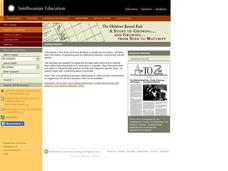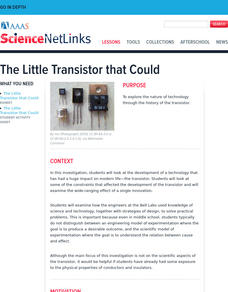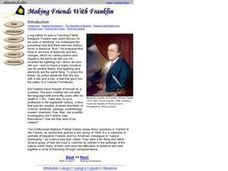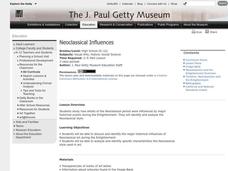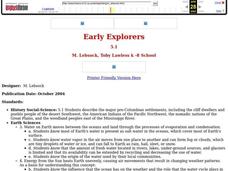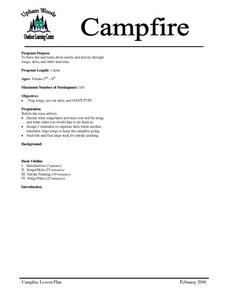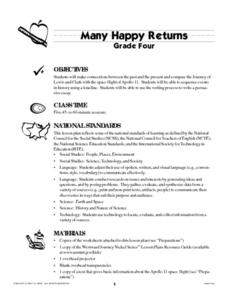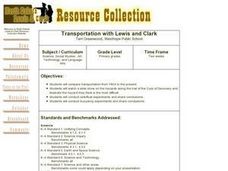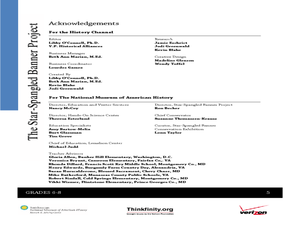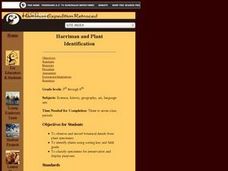Curated OER
Baga Drum
Students examine a Baga Drum in order to explore the history of the Baga people of West Africa. In this art history lesson plan, students recognize figures used in Baga Drum design that represent aspects of Baga culture. They also design...
Curated OER
Mississippi Gulf Coast Islands
Fourth graders complete a variety of exercises as they study the creation, history, and geography of the Mississippi coastal islands. They discover the natuaral forces that act on the islands and how these forces affect the habitats and...
Curated OER
The Little Transistor That Could
Students research the history of the transistor to explore the nature of technology. They complete a worksheet that coincides with given websites. Then they write a one-page essay about their findings.
Curated OER
Making Friends With Franklin
Students will reflect upon the life of Benjamin Franklin in order to understand his place in history. Emphasis is placed upon the development and contributions he made to modern science inquiry. The learner uses readings to do various...
Curated OER
Social Studies: When Diseases become Epidemic!
Student participate in oral discussions to be able to define epidemic and identify 3 instances in history in which epidemics occurred. They are introduced to the quarter theme, disease. Learners identify disease as a crucial dictator...
Curated OER
Why Should We Clean The Beach?
Students volunteer for the International Coastal Cleanup. They describe the purpose of the Lake Michigan Foundation and a history of the dunes. They reflect on their experiences with writing.
Curated OER
A Sense of West Virginia
Students consider their perceptions of the world through their 5 senses while visiting the West Virginia State Museum. In this West Virginia history instructional activity, students discover how knowing about the past helps with their...
Curated OER
A Neighborhood Expedition
Students plan and conduct an expedition through their neighborhood based on the techniques used by the Harriman Expedition to Alaska in 1899. They research the Harriman expedition on the internet and then create a route and collection...
Curated OER
The Last Great Race
Third graders identify and discover why the Iditarod race is done each year. They explore the historical significance of the Iditarod. Students also use web sites to research related topics, i.e. diseases (diptheria), geography of...
Curated OER
From Rags to (Paper) Riches: Explore Colonial Papermaking
Young scholars explore Colonial papermaking. In this Colonial America U.S. history lesson, students analyze two poems written in the 1690s about the Rittenhouse paper mill to learn about papermaking. Young scholars produce...
Curated OER
Neoclassical Influences
Students analyze neoclassical art. In this art history lesson plan, students listen to their instructor present a lecture regarding the details of the art produced during the Enlightenment.
Curated OER
Early Explorers
Fifth graders study early explorers. In this World history lesson, 5th graders draw an outline of a map labeling each part, build geographical features out of dough, and paint each of the land and water features.
Curated OER
America's Heartland
Fifth graders investigate imports and exports to discover its importance to America as a world power. In this Imports and exports lesson, 5th graders discuss how climate and natural resources aid a country in becoming a world...
Curated OER
Atlatl (Native Americans)
Students discover what an atlatl is and how to use it. In this Native American lesson, students discuss the history of the Native American atlatl and practice throwing with it. Students will analyze the effects of the atlatl in terms of...
Curated OER
Reporting Live From...
Students examine the many disasters in West Virginia. In this US history lesson, students write about and give an oral presentation of one of the disasters as if they were reporters.
Curated OER
Who Writes History?
Students examine why certain historical figures get credit for their accomplishments while others are forgotten. They read and discuss two informational handouts, discuss why people remember Columbus even if he was not the first person...
Curated OER
Campfire
Students have fun and investigate about the nature and history through songs, skits, and other activities. They sing songs, and act out skits. Students decide what songs or skits that they are going to sing. They sit around a campfire...
Indian Land Tenure Foundation
A Sense of Belonging
In order to understand how the land changes over time because of the people who live there, learners interview an elderly person about the past. Children ask an older family member to describe what the local area was like when they were...
Curated OER
Many Happy Returns
Students compare the journey of Lewis and Clark with the space flight of Apollo 11. Students sequence events using a timeline. Students write a persuasive essay trying to persuade the people of the US to support space exploration.
Curated OER
Transportation with Lewis and Clark
Students listen to a PowerPoint presentation and complete a Venn diagram comparing the methods of transportation in the early 1800s with today's transportation. They experiment with the buoyancy of keelboats.
Curated OER
Getting Fired Up
Learners explore first-person accounts of volcanic eruptions throughout time and use second-hand information about volcanoes. They use both types of accounts to write news articles covering the events of a historic volcanic eruption as...
Curated OER
Destructive Impact of Environment on Artifacts
Middle schoolers recognize that artifacts are destroyed over time. In this environmental factors on artifacts lesson, students experiment and observe through the microscope to find the environmental impact on artifacts. ...
Curated OER
Wappo Indians of Napa County
Third graders describe the American Indian nation in their local region long ago and in the recent past in terms of national identities, religious beliefs, customs, and various folklore traditions. They synthesize their findings into a...
Curated OER
Harriman and Plant Identification
Students observe and record botanical details from the plant specimens. They identify plants using sorting key and field guide and classify specimens for preservation and display purposes.
